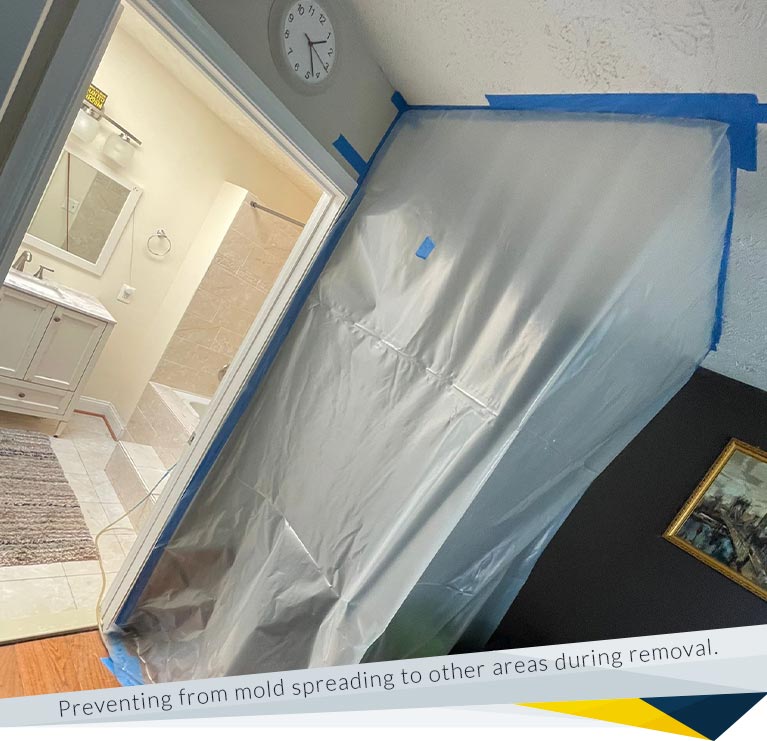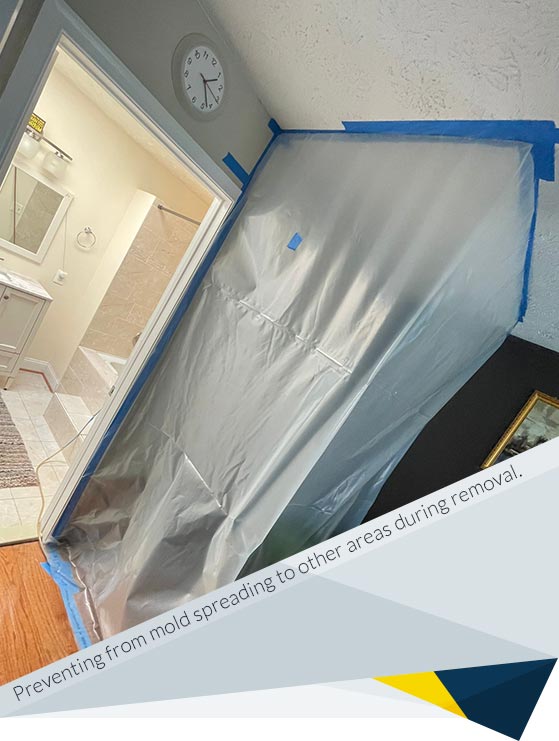
At FDP Mold Remediation, after our technicians have documented your mold problem and created a mold remediation plan, the next part of the process is to secure the mold affected area. This process, often known as mold isolation or mold containment, helps secure mold within the area that needs to be treated.
Though this might appear as a seemingly minor aspect of the mold remediation services, its quality and execution are of paramount importance. Proper use of protective equipment and meticulous attention to this stage safeguard the health of your building's occupants and the integrity of the building itself post-treatment.
Containing or isolating the mold affected area is crucial for keeping the mold from spreading to other parts of the building. Mold spreads by releasing spores. These spores travel through the air, often hitching a ride on your clothing and other items. Once the mold spores reach a new part of the building, they often remain dormant until they receive sufficient food or moisture. At that time, they can start growing.
The longer it takes to secure mold in the building, the more likely it is that mold spores will be able to spread to other areas. Waiting too long to begin the mold containment process could mean that you'll find yourself in need of mold remediation in another part of the building in just a few months.
Mold isolation doesn't just help prevent future incidences of mold growth. It also minimizes the potential for exposing building occupants to mold spores. Exposure to large quantities of mold spores can cause allergy-like symptoms, including difficulty breathing, runny nose, fatigue, and watery eyes. Some molds produce harmful mycotoxins that can lead to serious illness or more severe allergic reactions.
By effectively isolating a mold affected area prior to beginning additional mold remediation work, you can protect the health of building occupants, particularly those who are at risk of more severe reactions due to allergies or asthma.

Regardless of the size of the mold affected area, one of the first steps of the mold containment process is to install a HEPA-filtered negative air machine. HEPA filters are designed to remove 99.97% of mold and other airborne particles that are 0.3 microns in size - and an even greater percentage of smaller and larger mold particles.
This device is used to exhaust containment air to the outside of the building. In other words, this ensures that any mold spores that become airborne during the cleaning process will be trapped or vented outside, rather than remain indoors. While this aspect of mold containment remains the same in all of our mold remediation projects, other elements of mold isolation will vary somewhat based on the size and severity of the mold problem.
“Limited containment” practices are used when the size of the mold affected area ranges from 10 to 100 square feet.
We start by isolating and securing the area using 6-millimeter fire-retardant polyethylene sheeting and duct tape.This equipment serves as a barrier, ensuring containment air is exhausted outside the building. Essentially, it ensures that any mold spores that become airborne during the cleaning process are either trapped or redirected outdoors, preventing them from staying indoors. The use of such materials and personal protective equipment maintains a controlled pressure environment, which is pivotal in our mold remediation projects. While this aspect of mold containment is consistent across our projects, other facets of mold isolation can differ depending on the size and severity of the mold issue.
Finally, after the rest of the mold remediation work is complete, all filters from the building's HVAC system should be replaced. These filters are designed to trap dust, mold spores, and pollen. However, too much buildup could allow mold spores to recirculate through the home's HVAC system, or cause an airflow blockage that damages the HVAC.
“Full containment” practices are used for areas that have experienced over 100 square feet of mold contamination. These are usually severe cases with intense, long-term mold exposure. Ideally, by identifying and responding to a mold outbreak early on, most homeowners should never have to deal with an outbreak of this size.
Because of the scope of the mold outbreak, the full containment process is a bit more intensive than it is in limited containment. Supply and air vents, doors and windows, and pipe chases are secured with a double layer of 6-millimeter fire-retardant polyethylene sheeting and duct tape.
Our technicians also add an airlock entry for accessing the affected area. As Wei Sun, P.E. explains in an article for the ASHRAE Journal, “An airlock is a transitional space that typically has two doors in series to separate a controlled environment (such as cleanroom, lab, operating room, or isolation room) from a corridor, or vice versa. The two doors should be interlocked to avoid being opened at the same time. An airlock area is often ventilated with filtered supply air, with return or exhaust air to exit.”
By using this style of entry, technicians prevent spread from severely contaminated areas as they go through the mold remediation process. As with limited containment, the building's HVAC filters should be replaced once remediation is complete.
An important aspect of mold isolation is ensuring that technicians wear appropriate protective gear during their work. This gear limits their exposure to harmful mold spores, while also helping to keep them from accidentally spreading spores to previously unaffected areas. The type of protective gear that is necessary to ensure proper mold containment varies based on the size of the mold affected area.
For example, areas with less than 10 square feet of mold typically require less protection because the mold infestation is much less severe. Despite this, our technicians will wear gloves, an N-95 respirator mask, and goggles or other eye protection.
For an average-sized mold outbreak (between 10 and 100 square feet), our technicians will often use a half-face respirator with a HEPA filter instead of an N-95 respirator. Aside from gloves and eye protection, they will also wear disposable overalls for additional protection against mold spores.
This device is designed to expel containment air to the exterior of the building, enhancing indoor air quality. In essence, it guarantees that any mold spores becoming airborne during the cleaning are either trapped or channeled outside, ensuring they don't linger indoors. Personal protective equipment is crucial during this process. While this facet of mold containment is consistent in all our mold remediation endeavors, various components of mold isolation may differ based on the magnitude and severity of the mold challenge.
Mold containment is a crucial part of the mold remediation process in large part because of what could happen if mold is not properly secured. As noted earlier, extended mold exposure can cause serious allergic reactions and illness.
However, mold can also destroy property. Many items that are affected by mold, such as carpet or personal possessions, cannot be restored and must be thrown out. Mold could also contribute to wood rot and other structural problems that require major repairs. Securing the mold affected area isolates spores to limit the scope of the damage.
Spreading mold can also become a financial headache. Mold remediation is typically only covered by homeowner's insurance when it is related to a covered peril, such as water damage from a burst hot water heater. If you didn't take steps to contain the mold while addressing that damage, mold spores could spread and grow in other areas. Your insurance would likely not cover the new mold growth because it is not directly related to the previous incident.
Mold containment is often overlooked during DIY mold removal work, but it is one of the most important steps you can take. Effective mold isolation will keep spores from spreading to other areas, helping preserve occupant health and reducing your risk for additional mold growth in the future.
At FDP Mold Remediation, we take this part of the mold remediation process seriously to ensure adequate containment. Regardless of whether you're dealing with a situation that requires limited or full containment, our processes and protective gear will ensure effective results so everything is ready for the next step - mold removal and anti-microbial treatments.

